Actions at School Board Meeting
• Public Persists in Demanding:Public Control of Public Schools
• A New Public for a New Public Education is Emerging
Actions at School Board Meeting
Public Persists in Demanding:
Public Control of Public Schools
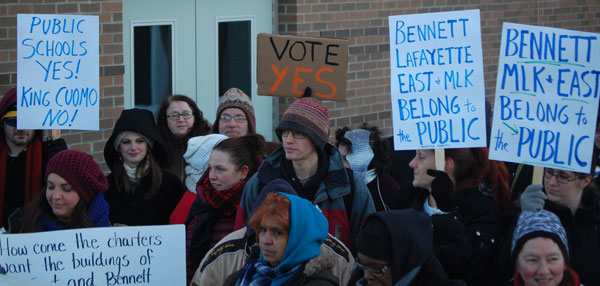
A militant and determined crowd demonstrated outside the School Board meeting January 28 and inside expressed the firm commitment to keeping our public schools open and public. This action  brought students, teachers, staff, alumni, parents and principals together, speaking and chanting with their united stand, Whose Schools? Our Schools! Who Decides? We Decide! Buses and vanloads of students came from Bennett, East and Lafayette, all scheduled for closure. More students, teachers and parents joined the fight, including those from MLK, Riverside, City Honors, Hutch Tech, McKinley and MST. Organizers succeeded both in activating the union to play a greater role and in broadening their independent organizing, using widespread leafleting, phone calls, social media, a large banner in front of Bennett, T-shirts demanding a YES Vote and more. Public meetings at the four schools the previous week also contributed to building the momentum. Outside and inside, the will of the people was clear: Vote Yes for the redesign plans of the four schools, Bennett, East, Lafayette and MLK and Keep Our Public Schools Open, Public and Raise Their Quality!
brought students, teachers, staff, alumni, parents and principals together, speaking and chanting with their united stand, Whose Schools? Our Schools! Who Decides? We Decide! Buses and vanloads of students came from Bennett, East and Lafayette, all scheduled for closure. More students, teachers and parents joined the fight, including those from MLK, Riverside, City Honors, Hutch Tech, McKinley and MST. Organizers succeeded both in activating the union to play a greater role and in broadening their independent organizing, using widespread leafleting, phone calls, social media, a large banner in front of Bennett, T-shirts demanding a YES Vote and more. Public meetings at the four schools the previous week also contributed to building the momentum. Outside and inside, the will of the people was clear: Vote Yes for the redesign plans of the four schools, Bennett, East, Lafayette and MLK and Keep Our Public Schools Open, Public and Raise Their Quality!

![]()

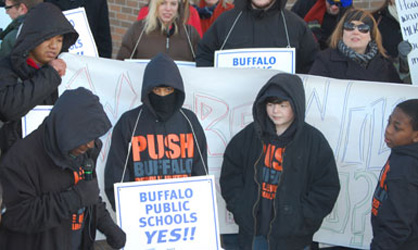
![]()
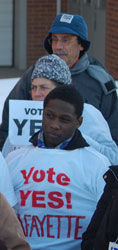
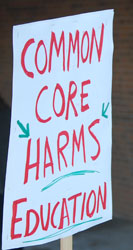
![]()
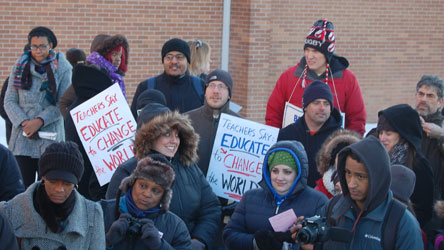

![]()
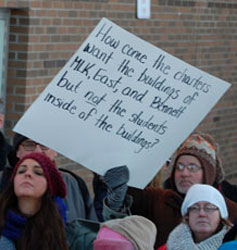
![]()

The demonstration was about 200 strong, twice the size of the one at the last board meeting. Participants were even more convinced of the need to fight for Public Control of Public Schools! Students, teachers, parents, principals all spoke out about the importance of keeping the schools public. Many raised their concerns that the students in the schools scheduled for closure will be forced out. They could easily be scattered to various schools, or perhaps so traumatized by losing their teachers and classmates they will not return to school and could instead end up in prison. While the four schools have in place innovative plans for their schools, for welcoming all students, for developing them as organizing centers for their communities, the board has nothing in place for these students. Speakers also expressed their objection to board plans to give Bennett and MLK to private charters for free! It can be said that such plans are crimes against the public, whose public dollars and efforts built these schools.

![]()
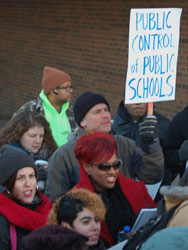

![]()

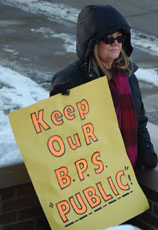
![]()
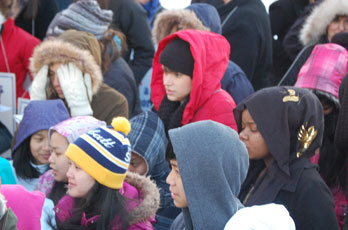
![]()
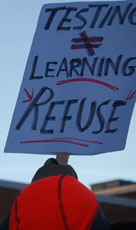
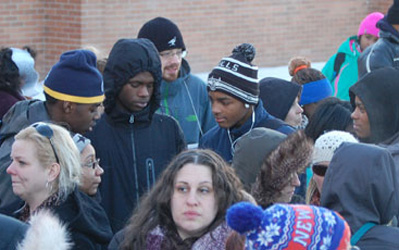
![]()

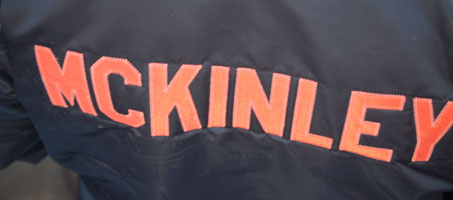
![]()
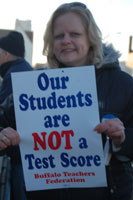
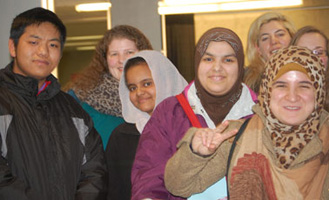
![]()
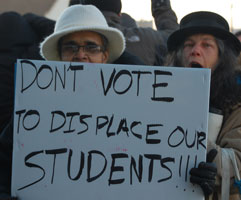
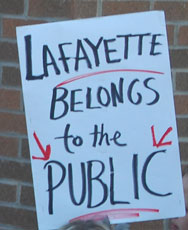
![]()
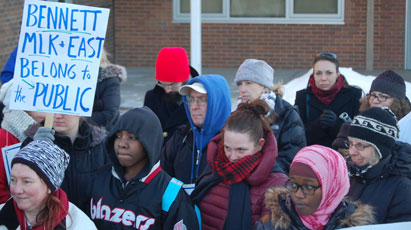

![]()

![]()
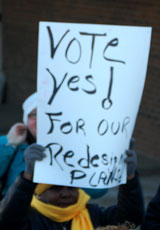
![]()

Inside the crowd was even larger with another 150 or more people joining in. As before, one after the other, speakers called for a Yes Vote on the Redesign plans created by the schools. They rejected the testing regimes being imposed to label schools, teachers and students as failing. Several students, teachers and alumni from Bennett spoke, along with teachers, parents and community activists from other schools.
One Bennett student made clear that Bennett students are not low performing and the school is not low performing. He spoke to the fact that Board members are on their cell phones during meetings and ignoring the speakers — something that is indeed low performing! Many others also spoke about the false labeling of students and schools as failing. It is a means to force the public schools to close, not a means to raise the quality of education. People also exposed the myth of “high performing” charters, which generally perform the same or worse than public schools. The difference is, the public funds these schools but has no control.
The Buffalo Teachers Federation (BTF) also put to rest the claims that the union stands in the way of the plans going forward. The BTF said it was prepared to have immediate votes in the four schools if the Board approved the plans that night. They also said if the board agreed there would be no changes to the plans, the BTF would organize immediate votes. The problem is not the teachers and the union. The problem is the refusal of the Board majority to listen to the public and represent its demands for a Yes Vote and for keeping the schools public and open.
The Board majority decided to postpone the vote, no doubt in part because of the broad and growing demand for a Yes Vote for all four schools. They perhaps think the public cannot sustain its resistance. They are dead wrong. As a speaker brought out, it is up to the public to decide and defend the equal right to education for all. Organizing is going forward to involve more students and retirees, to bring all the schools into the battle, to work for a Yes Vote and prepare for a No Vote. Either way, the firm stand is Our Schools, We Decide! Various tactics are being pursued as, whatever and whenever the vote, all plan to keep these public schools in public hands.
[TOP]
A New Public for a
New Public Education is Emerging
 On January 28 , students, teachers, parents and community activists, moved by their collective conscience, and as agents in a historically significant battle for democracy, will converge at Performing Arts High School in Buffalo (at Ferry and Masten) to demand public schools remain public. Students, teachers, parents and community activists are demanding that the substantial redesign plans developed by each school with significant input be approved by the Buffalo Board of Education (Bennett, East and Lafayette high schools and MLK elementary). These forces are opposing the closure of these schools and the transferring of these public assets to private charter operators, who will receive them at no cost and who will be subject to no real public oversight. It is clear that education deformers seek the transfer of public assets to the private domain, for private benefit in both political and economic terms. It is clear that education deformers want a private monopoly over public affairs. They want control over the public, and no longer even seek its consent. They want private, corporate control over what is inherently public, social and belonging to all.
On January 28 , students, teachers, parents and community activists, moved by their collective conscience, and as agents in a historically significant battle for democracy, will converge at Performing Arts High School in Buffalo (at Ferry and Masten) to demand public schools remain public. Students, teachers, parents and community activists are demanding that the substantial redesign plans developed by each school with significant input be approved by the Buffalo Board of Education (Bennett, East and Lafayette high schools and MLK elementary). These forces are opposing the closure of these schools and the transferring of these public assets to private charter operators, who will receive them at no cost and who will be subject to no real public oversight. It is clear that education deformers seek the transfer of public assets to the private domain, for private benefit in both political and economic terms. It is clear that education deformers want a private monopoly over public affairs. They want control over the public, and no longer even seek its consent. They want private, corporate control over what is inherently public, social and belonging to all.
Despite the incessant propaganda to the contrary, parents, students, teachers and community members have maintained that there is a direct link between public control of public schools and the quality of education provided. Through their redesign proposals and community work, they are directly countering the essence of the disinformation campaign of education deformers, who for more than three decades have promoted the view, long before King Cuomo, that the problem with public education is that it is public.
 These students, parents, teachers and community members have emerged as the educating and informing public. This public has become an authoritative source of information, a safeguard for collective wisdom, and a spring of new energy and hope. It, and not the so-called reformers and “high performers”, can be trusted. This emerging public authority arises from the necessity of the broad interests it serves and the relationships and organizations that comprise it, have fought for it, and work to sustain it. This representative public is emerging as a result of concrete work to defend public interests and oppose insane policies masquerading as accountability, and it has historical significance beyond tomorrow’s action. This new public stands as an important basis for advancing the general interests in the future; it is a powerful means for transforming people’s hope and energy into lasting change.
These students, parents, teachers and community members have emerged as the educating and informing public. This public has become an authoritative source of information, a safeguard for collective wisdom, and a spring of new energy and hope. It, and not the so-called reformers and “high performers”, can be trusted. This emerging public authority arises from the necessity of the broad interests it serves and the relationships and organizations that comprise it, have fought for it, and work to sustain it. This representative public is emerging as a result of concrete work to defend public interests and oppose insane policies masquerading as accountability, and it has historical significance beyond tomorrow’s action. This new public stands as an important basis for advancing the general interests in the future; it is a powerful means for transforming people’s hope and energy into lasting change.
Thus, these forces are emerging as a representative public capable of governing in service of the general interest. Similar forces have and are emerging across the country in cities like Philadelphia, New York, Detroit, New Orleans, Chicago, and elsewhere. We are in and part of this historical moment. This new public stands against the wrecking and irrationalism of those who wield power on the medieval basis of wealth-status. They demand all social institutions serve the narrowest, most self-serving interests. They trivialize the advent of public schools as a common good and obvious social necessity that cannot be privatized, nor subject to the logic of speculation.
Let’s be clear: the corporate agenda for education—high stakes testing, Common Core, charter schools, etc.—all this portends rigor-mortis for the body politic. Their “reforms” demand the emasculation of public interest and the removal of even the appearance of democratic governance. The education and active engagement of members of the body politic in matters that affect their lives cannot be tolerated under the new regime that is now being imposed, in education and in fact all social spheres. There is no role for the educated citizen because their is to be no citizen in the modern sense of the word. With a King such as Cuomo, there can only be the serf, which must be socialized (at public expense) to be “career ready,” a mere toiler for the master’s private benefit.
 Thus it is important to see the emerging representative public as a dignified and hopeful counter to the abject failure of current political institutions and the degradation of politics at the hands of those now usurping power at the local, state and federal level, the decaying and corrupt old public authorities. These wrecking forces do not bring order, but instead function to disrupt the formation of a new public interest through the imposition of chaos, fear, and social division. These are brutal forces, threatened by facts, logic or claims to the inherent value and dignity of human being, who increasingly subject teachers and students to their reductionist behavior management techniques in hopes of reducing the need for guns en masse.
Thus it is important to see the emerging representative public as a dignified and hopeful counter to the abject failure of current political institutions and the degradation of politics at the hands of those now usurping power at the local, state and federal level, the decaying and corrupt old public authorities. These wrecking forces do not bring order, but instead function to disrupt the formation of a new public interest through the imposition of chaos, fear, and social division. These are brutal forces, threatened by facts, logic or claims to the inherent value and dignity of human being, who increasingly subject teachers and students to their reductionist behavior management techniques in hopes of reducing the need for guns en masse.
The new public is a direct challenge to the legitimacy of those who refuse reasoned debate or the public’s right to govern in the open, not behind closed doors. The new public sees no sense in waging campaigns on the basis of asking illegitimate powers to yield to its ideas, evaluations and proposals. It is putting something else at the center. The new public is emerging by appealing to those it objectively serves. It is emerging as an authority on the basis that is has and can continue to provide real solutions, including solutions to the problem of creating the means for all—everyone, every individual and collective—to have a real say, as a right. It is this orientation that provides more space for the new public to grow as a powerful, legitimate and capable actor, animated by these convictions and the conscience of what is right and just. This provides hope and serves the aim of building a democratic education for and in service of all.
[TOP]
